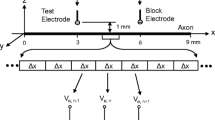Abstract
The response of a single Node of Ranvier to short duration biphasic stimulating currents was studied. Such stimulus patterns are known to be less likely to induce tissue damage than are longer monophasic stimuli. The presence of the anodic phase of a pulse pair was found to abolish excitation in cases where the cathodic phase alone was near threshold. In addition, peak twitch force from the tibialis anterior muscle of cat was found to be reduced by the use of biphasic motor nerve stimulation in place of monophasic stimulation. The abolition phenomenon could be eliminated by the introduction of a delay of 100 μs between the phases of a biphasic stimulus waveform.
Similar content being viewed by others
References
Brummer, S. B. and M. Turner. Electrochemical aspects of neuromuscular stimulation.Functional Neuromuscular Stimulation: Report of a Workshop. Washington, D. C., National Academy of Sciences, 1972.
Crago, P. E., P. H. Peckham, J. T. Mortimer and J. P. Van Der Meulen. The choice of pulse duration for chronic electrical stimulation via surface, nerve, and intramuscular electrodes.Ann. Biomed. Eng. 2:252–264, 1974.
Dodge, F. A. and B. Frankenhaeuser. Membrane currents in isolated frog nerve fiber under voltage clamp conditions.J. Physiol. 143:76–90, 1958.
Frankenhaeuser, B. A method for recording resting and action potentials in the isolated myelinated nerve fiber of the frog.J. Physiol. 135:550–559, 1957.
Frankenhaeuser, B., and A. F. Huxley. The action potential in the myelinated nerve fiber ofXenopus Laevis as computed on the basis of voltage clamp data.J. Physiol. 171:302–315, 1964.
Frankenhaeuser, B., and A. Persson. Voltage clamp experiments on the myelinated nerve fibre.Acta Physiol. Scand. 41(Suppl. 145):45–46, 1957.
Mortimer, J. T., D. Kaufman, and U. Roessmann. Tissue reaction to intramuscular electrical stimulation. Presented in Atlantic City, at 58th FASEB Meeting. Abstract inFed. Proc. 33(No. 3, Part 1):312, 1974.
Pudenz, Robert H., L. A. Bullara, Denise Dru, and M. D. Talhalla. Electrical stimulation of the brain II. Effects on the blood-brain barrier.Surg. Neurol. 4:265–270, 1976.
Tasaki, I. Initiation and abolition of the action potential of a single node of Ranvier.J. Gen. Physiol. 40:859–885, 1957.
Author information
Authors and Affiliations
Additional information
This research was supported by the National Institutes of Health, Grant No. NINCDS NO1-NS-2-2314 (Neural Prosthesis Program) and GM 01090-15 Training Grant.
Rights and permissions
About this article
Cite this article
van den Honert, C., Mortimer, J.T. The response of the myelinated nerve fiber to short duration biphasic stimulating currents. Ann Biomed Eng 7, 117–125 (1979). https://doi.org/10.1007/BF02363130
Issue Date:
DOI: https://doi.org/10.1007/BF02363130




